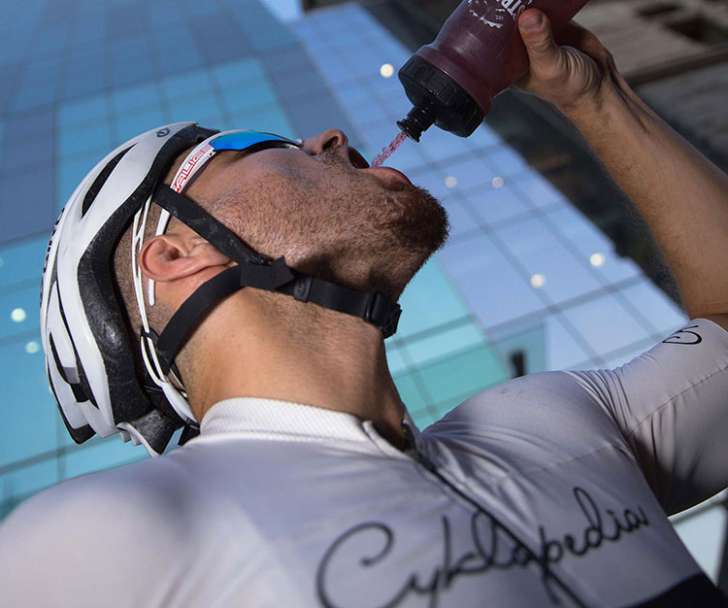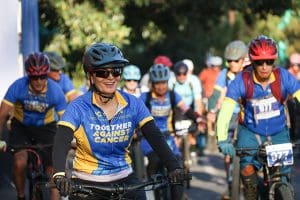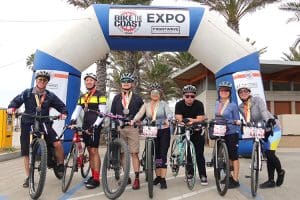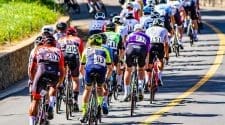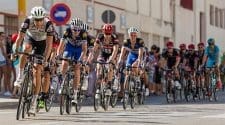With the Higher Temperatures of Summer, it is Important to Hydrate While Bicycling
Problems related to the hydration of cyclists and the athlete’s organism are still quite common. Although there is a growing awareness of the importance of this issue, the estimation of the water-electrolyte balance in periods around training or competitions leaves much to be desired. It is worth noting that already 2% of the weight loss resulting from the loss of water during exercise reduces the efficiency (estimated at about 10%) and affects the deterioration of sports performance. Everyone would like to avoid a worse place at the finish line, seemingly so trivial, and so to the point!
Benefits of hydration
Taking fluids during exercise helps the body to function properly and removes the risk of dehydration, which increases with the time of activity.
The most important benefits of hydration during exercise are maintaining proper oxygen transport
- Efficient transport of energy substrates to the muscles
- Maintaining adequate blood flow
- Removal of emerging metabolites from muscles, including lactic acid
- Ensuring thermoregulation by secretion of sweat
- Maintaining nervous system efficiency in pulse conductivity
- Maintaining adequate air humidification and lung ventilation
- Reducing the risk of injury
Fluid requirements
Our body uses water and electrolytes through feces, tears, spit, urine, sweat and breathing.
Factors contributing to increased water loss include high temperature, high humidity, lack of wind, larger body area, genetic factors.
It is estimated that the body at rest consumes about 30ml/kg body weight/day. Depending on the weight of the athlete it gives us about 2l – 3.5l / day to consume in order to ensure proper functioning of the body.
In the case of active people and athletes, water loss during physical activity should also be added to the daily balance. Water loss during training increases proportionally with the intensity and length of physical activity.
According to standards, the loss of 1-1.5 l/hour during intense exercise is assumed. However, these values may differ significantly from reality. Therefore, it is recommended to take an individual approach and estimate the sweating rate for each athlete.
The rate of sweating can be assessed by measuring the body weight directly before and after the exercise. It is best that the effort is intense, short and you should not urinate or consume fluids or food during the exercise. Before you measure your body weight, wipe yourself thoroughly and take off your sweat-wet clothes. The best way to do this is to do both naked measurements.
For example, you can do 30 minutes of intense activity and multiply the difference in body weight by 2, which will give us our individual sweating rate per hour of intense exercise.
The sum of the water loss during exercise and the resting turnover value gives us our daily water requirement. However, we should also take into account the training time and climatic conditions as well as individual variability.
In ultra-endurance sports, the recommended number of fluid intake may reach even more than 20l/day, so do not do it on your own, because of the risk of underestimation and the possibility of dehydration.
Particular attention should be paid to the elderly, in whom the amount of water in the body decreases with age. Older people practicing competitive sports (over 35 years of age) feel thirsty much later, the elasticity of tissues decreases and the risk of injury increases. In such people, it is much easier to get dehydrated and overheated during intensive exercise.
Effects of dehydration
A human body consists mainly of water. During intensive exercise, sweating is the body’s defense reaction to increased heat generation in muscles.
The rate of sweating during marathons in unfavorable conditions (no wind, high temperature and humidity) can reach even more than 3l/hour.
Such a large loss of water requires constant water supply. Unfortunately, the feeling of thirst is delayed and occurs only when the bodyweight drops by 2%. The occurrence of such dehydration is almost impossible to make up for during competitions.
Loss of water through sweating and the transfer of fluids from blood plasma to muscles and other tissues to plasma, and consequently the concentration of blood affects the deterioration of the thermoregulatory function of the body.
The result of this mechanism is overheating and heatstroke. If the intensity of the effort is not reduced, it may result in the risk of interruption of the competition and health consequences.
Blood density is also conducive to cell damage and, as a result, the transport of oxygen deteriorates. Dehydration also affects muscles and joints, increasing the risk of injury.
Dehydration |
Effects |
| 1% | Capacity reduction
deterioration of the cardiovascular system |
| 3% | critical capacity reduction |
| 5-10% | Headaches, drowsiness, concentration disorders, nausea, accelerated breathing, muscle spasms |
| >10% | Life threat, fainting, visual disturbances |
Hyponatremia
Until now, it may seem that drinking very large amounts of water is beneficial for the body, but water is uneven.
Hyponatremia occurs when you consume much more clean water than you lose or have low electrolyte levels.
It is characterized by a low concentration of sodium in the blood serum (< 130 mmol/l). The first symptoms that can be observed are swelling of the feet and hands, followed by wheezing, coughing and encephalopathy with consciousness disorders. In the worst case (<120 mmol/l), death can occur.
Hyponatremia in sport may occur in case of poorly chosen hydration strategy and electrolyte deficiencies. In order to cope with the first symptoms, it is necessary to stop consuming pure water and give sodium, e.g. in the form of electrolytes – suction tablets.
Controlling the hydration
We can control the hydration of the body by checking the osmolality, specific weight of urine or by conducting observations on urination.
The first way – checking osmolality is an extremely expensive variant and requires the purchase of specialized expensive equipment. Rather not for use by amateur athletes, but during training camps for sportsmen and sportswomen.
The second method can be controlled by gravimetry, refractometry or chemically. Gravity and Refractometry require the urine temperature to be checked. Without specialist knowledge and the ability to make appropriate corrections, these methods are useless.
The chemical method is already more friendly because in it we use strips that everyone can buy in the pharmacy. For athletes, it seems to be accurate and trouble-free.
The last and contrary to appearances quite effective method is to observe and keep records of urination. If the urine is straw-colored or colorless and the mycoses are regular every 4 hours, we have a high probability that we are hydrated. The darker the color and the less frequent the visits to the toilet, the lower the level of hydration.
Please note that the control of hydration by osmolality or the specific gravity of urine can give false results during the intensive hydration phase, e.g. before a competition.
Hydration plan during, during and after the event
In case of hydration before the competition on long distances, the process should be started preferably 2 days before the start.
To do this, you should increase the supply of sodium in your diet. The easiest way to do this is to use isotonic and various forms of electrolytes, salting food or introducing products with a higher sodium content such as sea fish, small quantities of snacks such as sticks or crackers. In addition to sodium, calculate your fluid requirements and gently exceed them during these two days (no more than 10%).
During the competition, care must be taken to ensure that dehydration occurs as late as possible (in the case of long distances, this is unavoidable).
Already during the preparation phase, develop habits to reach for fluids frequently and drink small sips at short intervals. Single fluid intake should not exceed 300-400ml due to the risk of gastrointestinal problems.
The optimal amount seems to be 150-200ml. The frequency of fluid retrieval should be as frequent as possible, and with constant access to fluids, it should be appropriate every 10 minutes. During the competition, we should try to meet the previously calculated demand for fluids for the duration of the competition.
If we do not have permanent access to fluids, we should carefully plan the amount of fluids taken at certain times before the competition. Additionally, when preparing for the competition, you should increase your stomach emptying capacity by training with more fluids and food during the exercise.
Drinks during the competition should correspond as much as possible to the taste preferences of the competitor, because of the race time the competitor is “doomed” to continuous intake of them and should feel psychic comfort while consuming them.
A feeding and hydration plan should be developed by the staff and a nutritionist to ensure maximum comfort and delay the occurrence of fatigue. For very long distances, electrolyte intake in tablet form should be considered between 2 and 3 hours of competition.
Care should also be taken to ensure that drinks are not too cold due to the risk of gastrointestinal cramps and slower absorption.
After the competition, it will be appropriate to equalize fluids. The optimal strategy seems to be to take a body measurement directly before and after the competition.
The competitor should take 125-150% of the fluid from the difference in body mass measurement.
The hydration time depends on the distance covered and should vary from a few hours to a maximum of 2 days. Equalization of fluids should be carried out in small portions every 15 minutes.
Alcohol after the competition is not a desirable issue. It is worth getting some common sense.
If the next start is within a few days, the optimal solution would be not to reach for alcohol because of the fact that it very much delays the process of hydration after the competition and has a diuretic effect which additionally does not favor the state of dehydration.
However, if the next start is over a week of time, there are no contraindications within reasonable limits – unless there are symptoms of exhaustion and fatigue.
Type of drinks used during physical activity
The type of drink you choose should depend on the expected loss of water or electrolytes and the duration of exercise.
Among the drinks we distinguish:
a) Hypotonic drinks – they are characterized by low osmolality (<270 mOsm/l) and their carbohydrate content is less than 6%. They are well absorbed from the gastrointestinal tract and may lead to hyponatremia. It is assumed that they are optimal for efforts shorter than 1 hour.
b) Isotonic drinks – the most commonly used, best for long-term efforts on long journeys. They have similar osmolality as human body fluids (300-330 mOsm/l), which results in the fastest absorption time. They are composed of 6-10% carbohydrates and 460-1150mg/l sodium.
c) Hypertonic drinks – they have the highest osmolality (>330 mOsm/l) and the highest carbohydrate content – over 10%. These include fruit juices or shakes with a protein supplement. Their role is to help them regenerate.
Above article by Damian Chlanda, Cyklopedia
No products found.


